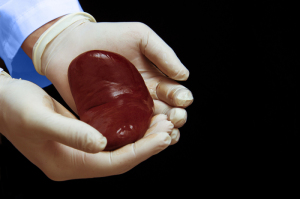by
John R. Fischer, Senior Reporter | May 23, 2018

Surgeons used 3-D printed models of
Dexter's abdomen and his father kidney to
pre-plan the transplant
Two-year-old Dexter Clark can now enjoy a full meal without a feeding tube, thanks to a lifesaving kidney transplant supported by 3D printing.
Using Stratasys’ multi-material 3D printing technology, surgeons at Guy’s and St. Thomas NHS Foundation Trust in London produced models to help plan for safely implanting a kidney from Dexter’s father into the young infant’s abdomen. The hospital is the first of any to use this technology to map out a successful transplant of an adult kidney into a small child with anatomical complexities.
“The ability to print a 3D model of the patient’s anatomy in varying textures, with the intricacies of the blood vessels clearly visible within it, enables us to differentiate critical anatomical relations between structures,” Pankaj Chandak, the transplant registrar at Guy’s and St Thomas’ NHS Foundation Trust, told HCB News. “The flexible materials also allowed us to better mimic the flexibility of organs within the abdomen for simulation of the surgical environment.”



Ad Statistics
Times Displayed: 55535
Times Visited: 1620 Ampronix, a Top Master Distributor for Sony Medical, provides Sales, Service & Exchanges for Sony Surgical Displays, Printers, & More. Rely on Us for Expert Support Tailored to Your Needs. Email info@ampronix.com or Call 949-273-8000 for Premier Pricing.
In need of a kidney since birth, Dexter’s best hope was a donated one from his father, whose own kidney was larger-than-average for an adult male, a fact that worried clinicians about the potential feasibility and safety of a transplant. The risk was also raised by Dexter weighing less than 22 lbs.
Not wanting conventional imaging limitations to interfere with pre-surgical planning, surgeons turned their attention to a Stratasys 3D printer, producing two patient-specific models from CT scans of Clark’s abdomen and his father’s kidney.
The models enabled surgeons to better evaluate depth perception and space within the baby’s abdomen, a challenge with imaging in pre-surgical planning. They also eliminated the need to place Clark under anesthesia and reduced the need for invasive surgical exploration to determine if such an operation were possible, given the risks involved.
The team then used the models during the operation to assess how the kidney should lie and fit into the abdomen, enabling a safe and successful transplant.
“Guy’s and St Thomas’ NHS Foundation Trust is pushing the boundaries of what can be achieved with multi-material 3D printing within healthcare,” Michael Gaisford, Stratasys’ director of marketing for Stratasys Healthcare Solutions, said in a statement. “It is a clear demonstration of the ability for 3D printing to enable physicians to better plan, practice and determine the optimal surgical approach. We are delighted to see Dexter has fully recovered and hope many other children can benefit from such forward-thinking applications of our technology.”
Dexter is now able to eat solid foods, an ability that his mother, Emily, attributes to the surgeons at Guy’s and St. Thomas’ NHS Foundation trust and the medical innovations now capable through the use of 3D printing.
“We always knew the operation would be complicated, but knowing that the surgeons had planned the surgery with 3D models that matched the exact anatomy of my husband’s kidney and son’s abdomen was extremely reassuring,” she said in a statement. “We hope that Dexter’s case will offer other suffering families similar reassurance that cutting-edge technology, such as 3D printing, can help surgeons better treat their loved ones.”
The printer was purchased from U.K. Partner, Tri Tech 3D.
Statasys did not respond for comment.

